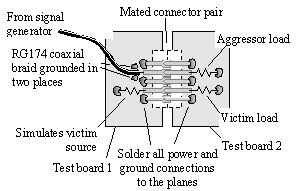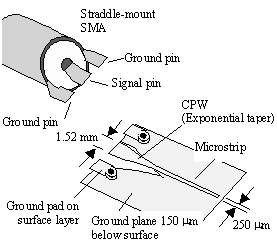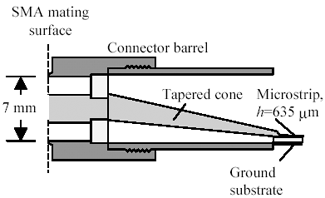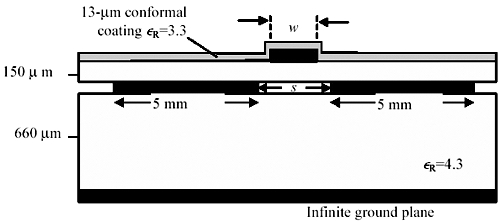Pcb Connectors
5.4.1 Mutual Understanding
POINTS TO REMEMBER
- Connector crosstalk in open-pin-field connectors acts through a transformer-like principle.
- Separating the loops of signal current within a connector by providing private power or ground pins for each signal reduces crosstalk.
- Reducing the current in the aggressive circuit reduces crosstalk.
5.4.2 Through-Hole Clearances
POINT TO REMEMBER
- Never assume your fabrication shop will build the board the way you ask. Always check.
5.4.3 Measuring Connectors
POINT TO REMEMBER
- Three primary measures of connector performance are signal fidelity, crosstalk, and EMI.
5.4.4 Tapered Transitions
[39] The NPW technique usefully compensates for a signal-mounting pad that is too large given the signal-to-ground spacing of your board. The opposite problem (signal pad too small) is solved by adding capacitance to the signal pin (i.e., enlarging it).
POINT TO REMEMBER
- A tapered transition maintains constant impedance when interconnecting transmission lines having widely different physical scales .
5.4.5 Straddle-Mount Connectors
High Speed Digital Design Online Newsletter , Vol 4, Issue 18In response to my previous EDN column, (Section 5.4.4) "Tapered Transitions," I received numerous messages asking, What is a straddle-mount connector? A straddle-mount connector is one designed to hang over the edge of a pcb, as opposed to a connector that sits up on one side of the board only. Connectors that sit up on one side of the board are convenient for mechanical reasons, as they absorb almost no mechanical headroom below the plane of the board (beyond that required to clear the back sides of the through-hole pins, if they have them). The disadvantage of a one-sided connector is that the connector pins are necessarily displaced up above the plane of the board (and the plane of the circuits), meaning that your signals must travel up from the board, then across through the connector, and then back down on the other side. In doing so the signals will encounter some inevitable parasitic inductance and capacitance. A straddle-mount connector locates all its pins close to the plane of the pcb. It is used only at the edge of a board, as some part of the mating assembly of the connector is usually designed to hang off the edge of the board, protruding down below the plane of the board. This style of connector requires mechanical headroom below the plane of the board. It is called a straddle-mount connector because, when viewed from the side, the connector assembly appears to straddle the edge of the board, as opposed to " riding on top" of the board. The main advantage of a straddle-mounted connector is the reduction in the distance your signal must flow when traversing the connector. Because no long pins are required to bring your signals up out of the plane of the board, the straddle-mount connector may achieve a much more intimate connection between the grounds of the two mated circuits than is otherwise possible using a connector that sits up on one side of the board only. An example of a straddle-mounted (also called edge-mounted) SMA connector ”and I don't mean to imply it's the best one; it's just an example [40] ”is the Tyco Electronics P/N: 449692-1. Another question I got was, What's an Eisenhart connector? The Eisenhart connector was a very old N-type connector documented in Gupta and Garg's book [39] . I mentioned it as an example of where someone successfully used the tapering principle. I didn't intend for anybody to rush out and buy one...and I can't find a supplier that has any. If you locate one that's still available, let me know. It may now go by a different name . |
[40] At the time of publication, the Web link for this part was http://catalog.tycoelectronics.com/TE/docs/pdf/1/22/208221.pdf.
POINT TO REMEMBER
- A straddle-mount connector locates all its pins close to the plane of the pcb.
5.4.6 Cable Shield Grounding
High Speed Digital Design Online Newsletter , Vol 2, Issue 2I received numerous messages about cable grounding during my tenure as chief technical editor for the IEEE 802.3 Gigabit Ethernet standard. One part of that standard, the 1000BASE-CX link, runs at a data speed of 1.25 Gb/s (1.25 ·10 9 bits per second) over two-pair, 150-ohm, balanced cabling. The link uses one pair for the transmit direction and another pair for the receive direction. The 150-ohm balanced cabling has an overall shield. Some of the correspondents questioned the need for grounding the cable shield to the equipment chassis at both ends, suggesting that it should be grounded at one end only. Others suggested capacitively coupling the cable shield to the chassis, or coupling through parallel R-C networks. These suggestions were made to allay concerns about large AC power currents that might flow through the shield, should the shield become connected to differing 60-Hz potentials at each end. Here's how I replied. Reply In high-speed digital applications, a low impedance connection between the shield and the equipment chassis at both ends is required in order for the shield to do its job. The shield connection impedance must be low in the frequency range over which you propose for the shield to operate . The measure of shield connection efficacy for a high-speed connector is called the ground-transfer impedance, or shield-transfer impedance, of the connector, and it is a crucial parameter. In low-speed applications involving high-impedance circuitry , where most of the near-field energy surrounding the conductors is in the electric field mode (as opposed to the magnetic field mode), shields need only be grounded at one end. In this case the shield acts as a Faraday cage surrounding the conductors, preventing the egress (or ingress) of electric fields. In high-speed applications involving low-impedance circuitry, most of the near-field energy surrounding the conductors is in the magnetic field mode, and for that problem, only a magnetic shield will work. That's what the double-grounded shield provides. Grounding both ends of the shield permits high-frequency currents to circulate through the shield, providing a magnetic shielding effect. For a magnetic shield to operate properly, you must provide means for current to enter (or exit) at both ends of the cable. As a result, a low-impedance connection to the chassis, operative over the frequency range of our digital signals, is required at both ends of your shielded cable [49] . How low an impedance is necessary? In the 1000BASE-CX cable the signal wires couple to the shield through an impedance of 75 ohms. That's another way of saying that the common-mode impedance of the cable is roughly 75 ohms. The standard requires that the shield be tied to the local chassis ground through an impedance of 0.1 ohm or less. In such a configuration if you drive the signal wires with a common-mode voltage, you would expect to measure on the shield a voltage equal to (0.1/75) = 0.0013 times the common-mode voltage driven on the signal wires. The shield in this case should deliver a 57 dB shielding effectiveness. These are the specifications that our IEEE 802.3z 1000BASE-CX copper cabling group feels are necessary to meet FCC/VDE radiated emission regulations. In summary, the impedance between the shield and the chassis at the frequency of operation (about 1 GHz) must be less than 0.1 ohm. To achieve such performance with a capacitively coupled shield, the effective series inductance of the capacitor would have to be limited to less than about 16 pico-henries. That small an inductance cannot be implemented in a leaded component ”you would need a very low-inductance distributed capacitance, possibly implemented as a thin gasket distributed all the way around the connector shell, insulating the connector shell from the chassis. We have seen proposals for this type of connector, but have not seen one work in actual practice. The BERG MetaGig shielded connector exceeds the requirement for a shield transfer impedance. It does so by providing a direct metallic connection between chassis and shield that goes all the way around the connector pins, completely enclosing the signal conductors. A direct metallic connection is the only way we have found to beat the radiated emissions limits. Keep in mind that the short copper link we are discussing (P802.3z clause 39) is intended for use inside a wiring closet. It only goes 25 meters . It will be used between pieces of equipment intentionally tied to the same ground (we call out in the specification that this must be the case). Between such pieces of equipment there will be no large circulating ground currents. For longer connections, we provide other links types that do not require grounding at either end ( multimode fiber, single mode fiber, and category-5 unshielded twisted pairs). Direct grounding of the shield at both ends is the correct choice for a short, high-speed connection. |
POINT TO REMEMBER
- A high-frequency shield needs direct metallic contact with the product chassis, completely surrounding the signal conductors.
Fundamentals
- Impedance of Linear, Time-Invariant, Lumped-Element Circuits
- Power Ratios
- Rules of Scaling
- The Concept of Resonance
- Extra for Experts: Maximal Linear System Response to a Digital Input
Transmission Line Parameters
- Transmission Line Parameters
- Telegraphers Equations
- Derivation of Telegraphers Equations
- Ideal Transmission Line
- DC Resistance
- DC Conductance
- Skin Effect
- Skin-Effect Inductance
- Modeling Internal Impedance
- Concentric-Ring Skin-Effect Model
- Proximity Effect
- Surface Roughness
- Dielectric Effects
- Impedance in Series with the Return Path
- Slow-Wave Mode On-Chip
Performance Regions
- Performance Regions
- Signal Propagation Model
- Hierarchy of Regions
- Necessary Mathematics: Input Impedance and Transfer Function
- Lumped-Element Region
- RC Region
- LC Region (Constant-Loss Region)
- Skin-Effect Region
- Dielectric Loss Region
- Waveguide Dispersion Region
- Summary of Breakpoints Between Regions
- Equivalence Principle for Transmission Media
- Scaling Copper Transmission Media
- Scaling Multimode Fiber-Optic Cables
- Linear Equalization: Long Backplane Trace Example
- Adaptive Equalization: Accelerant Networks Transceiver
Frequency-Domain Modeling
- Frequency-Domain Modeling
- Going Nonlinear
- Approximations to the Fourier Transform
- Discrete Time Mapping
- Other Limitations of the FFT
- Normalizing the Output of an FFT Routine
- Useful Fourier Transform-Pairs
- Effect of Inadequate Sampling Rate
- Implementation of Frequency-Domain Simulation
- Embellishments
- Checking the Output of Your FFT Routine
Pcb (printed-circuit board) Traces
- Pcb (printed-circuit board) Traces
- Pcb Signal Propagation
- Limits to Attainable Distance
- Pcb Noise and Interference
- Pcb Connectors
- Modeling Vias
- The Future of On-Chip Interconnections
Differential Signaling
- Differential Signaling
- Single-Ended Circuits
- Two-Wire Circuits
- Differential Signaling
- Differential and Common-Mode Voltages and Currents
- Differential and Common-Mode Velocity
- Common-Mode Balance
- Common-Mode Range
- Differential to Common-Mode Conversion
- Differential Impedance
- Pcb Configurations
- Pcb Applications
- Intercabinet Applications
- LVDS Signaling
Generic Building-Cabling Standards
- Generic Building-Cabling Standards
- Generic Cabling Architecture
- SNR Budgeting
- Glossary of Cabling Terms
- Preferred Cable Combinations
- FAQ: Building-Cabling Practices
- Crossover Wiring
- Plenum-Rated Cables
- Laying Cables in an Uncooled Attic Space
- FAQ: Older Cable Types
100-Ohm Balanced Twisted-Pair Cabling
- 100-Ohm Balanced Twisted-Pair Cabling
- UTP Signal Propagation
- UTP Transmission Example: 10BASE-T
- UTP Noise and Interference
- UTP Connectors
- Issues with Screening
- Category-3 UTP at Elevated Temperature
150-Ohm STP-A Cabling
- 150-Ohm STP-A Cabling
- 150- W STP-A Signal Propagation
- 150- W STP-A Noise and Interference
- 150- W STP-A: Skew
- 150- W STP-A: Radiation and Safety
- 150- W STP-A: Comparison with UTP
- 150- W STP-A Connectors
Coaxial Cabling
- Coaxial Cabling
- Coaxial Signal Propagation
- Coaxial Cable Noise and Interference
- Coaxial Cable Connectors
Fiber-Optic Cabling
- Fiber-Optic Cabling
- Making Glass Fiber
- Finished Core Specifications
- Cabling the Fiber
- Wavelengths of Operation
- Multimode Glass Fiber-Optic Cabling
- Single-Mode Fiber-Optic Cabling
Clock Distribution
- Clock Distribution
- Extra Fries, Please
- Arithmetic of Clock Skew
- Clock Repeaters
- Stripline vs. Microstrip Delay
- Importance of Terminating Clock Lines
- Effect of Clock Receiver Thresholds
- Effect of Split Termination
- Intentional Delay Adjustments
- Driving Multiple Loads with Source Termination
- Daisy-Chain Clock Distribution
- The Jitters
- Power Supply Filtering for Clock Sources, Repeaters, and PLL Circuits
- Intentional Clock Modulation
- Reduced-Voltage Signaling
- Controlling Crosstalk on Clock Lines
- Reducing Emissions
Time-Domain Simulation Tools and Methods
- Ringing in a New Era
- Signal Integrity Simulation Process
- The Underlying Simulation Engine
- IBIS (I/O Buffer Information Specification)
- IBIS: History and Future Direction
- IBIS: Issues with Interpolation
- IBIS: Issues with SSO Noise
- Nature of EMC Work
- Power and Ground Resonance
Points to Remember
Appendix A. Building a Signal Integrity Department
Appendix B. Calculation of Loss Slope
Appendix C. Two-Port Analysis
- Appendix C. Two-Port Analysis
- Simple Cases Involving Transmission Lines
- Fully Configured Transmission Line
- Complicated Configurations
Appendix D. Accuracy of Pi Model
Appendix E. erf( )
Notes
EAN: N/A
Pages: 163





